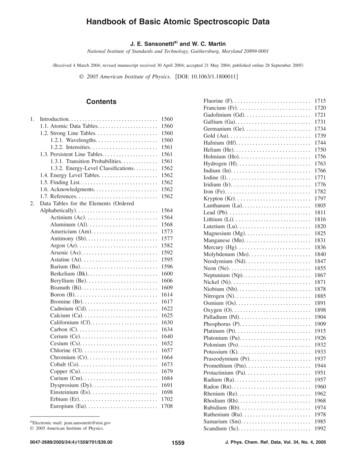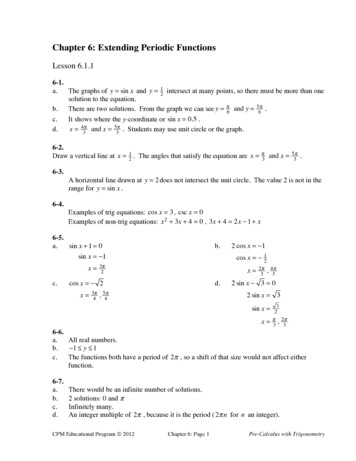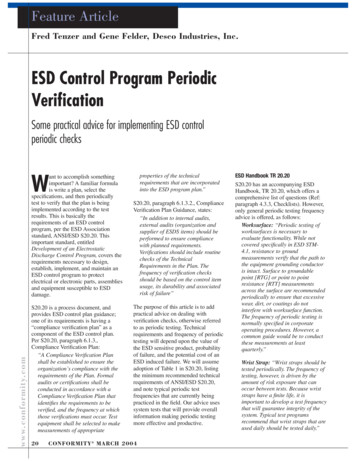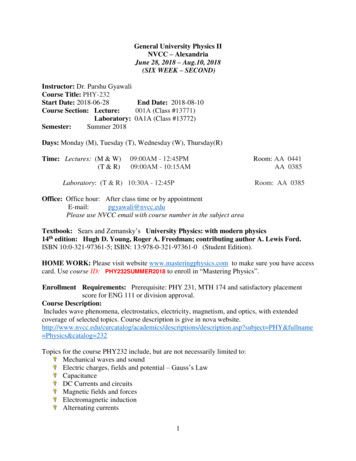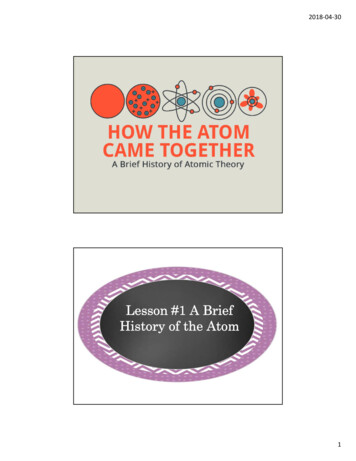
Transcription
2018‐04‐301
2018‐04‐302
2018‐04‐303
2018‐04‐304
2018‐04‐305
2018‐04‐306
2018‐04‐307
2018‐04‐308
2018‐04‐309
2018‐04‐30What particles are atoms made of?For some time, people thought that atoms were thesmallest particles and could not be broken into anythingsmaller.Scientists now know that atoms are actually made fromeven smaller particles. There are three types:protonneutronelectronHow are these particles arranged inside the atom?20 of 47 Boardworks Ltd 200710
2018‐04‐30How did our understanding change?J.J Thomson discovered electrons, and proposed theexistence of a ( ) particle.It wasn’t until Rutherford’s famousgold foil experiment that the protonwas discovered, and atoms werethought to me mostly empty space. Henamed the centre of atoms thenucleus.Bohr improved on this model proposingthat electrons move around the nucleusin specific layers called shells.It was James Chadwick who discovered particleswith no charge, which he named neutrons.21 of 47 Boardworks Ltd 2007What is the structure of an atom?Protons, neutrons and electrons are not evenly distributed inan atom.The protons and neutronsexist in a dense core at thecentre of the atom. This iscalled the nucleus.The electrons arespread out around theedge of the atom. Theyorbit the nucleus inlayers called shells.22 of 47 Boardworks Ltd 200711
2018‐04‐30Labelling the atom23 of 11 Boardworks Ltd 2011Mass and electrical chargeThere are two properties of protons, neutrons and electronsthat are especially important: mass electrical charge.ParticleMassChargeproton1 1neutron10electronalmost 0-1The atoms of an element contain equal numbers of protonsand electrons and so have no overall charge.24 of 47 Boardworks Ltd 200712
2018‐04‐30How many electrons?Atoms have no overall electrical charge and are neutral.This means atoms must have an equal number ofpositive protons and negative electrons.The numberof electronsis thereforethe same asthe 2copper293529iodine537453Atomic number is the number of protons rather thanthe number of electrons, because atoms can lose or gainelectrons but do not normally lose or gain protons.25 of 47 Boardworks Ltd 2007Atomic Number (Z)The number of protons in an atom is known as the atomic number or protonnumber. always the same for a particular element. The number of protons identifies the element! is also equal to the positive charge of the nucleus (aka the )Example:If an atom has Z 12, then it MUST be an atom ofIf an ion has Z 41, then it MUST be an ion ofIf the nuclear charge of a species is 24, then it MUST be an atom or ion ofThe overall charge on an atom is zero becausethe number of number ofThe charge on any ion number of e–or( )( ).It is the smaller of the two numbers shown in mostperiodic tables. (usually on top depends where you’re looking)26 of 47 Boardworks Ltd 200713
2018‐04‐30Mass Number (A)mass number number of protons number of neutronsElectrons have a mass of almost zero, which means that the mass of each atomresults almost entirely from the number of protons and neutrons in the nucleus. Does not appear in the periodic table! (not in this exact form) Can be expressed in number of ways:Carbon-12 oror Does not uniquely identify the element!e.g. 3H : p, n , 3He : p, nThe larger of the two numbers shown in most periodic tables,which you are probably familiar with is mass .actually showsthe relative.27 of 47 Boardworks Ltd 2007What’s the mass number?mass number number of protons number of neutronsWhat is the mass number of these r293564cobalt273259iodine5374127germanium32417328 of 47 Boardworks Ltd 200714
2018‐04‐30How many neutrons?number of neutrons mass number - number of protonsnumber of neutrons mass number - atomic numberHow many neutrons are there in these 2389214629 of 47 Boardworks Ltd 2007What are isotopes?Isotopes are atoms of the same element that containdifferent numbers of neutrons.mass numberis differentatomic numberis the samecarbon-12carbon-13The reactivity of different isotopes of an element isidentical because they have the same number of electrons.The different masses of the atoms means that physicalproperties of isotopes are slightly different.30 of 26 Boardworks Ltd 200915
2018‐04‐30IsotopesOnly a few elements (e.g. phosphorus)are monoisotopic (only have one naturallyoccurring isotope).Most elements (e.g. sulfur) have two or moreisotopes.Question: Why doesn’t mass number appear on the periodic table?Answer: Because mass numbers are specific to particular isotopes andmost elements are actually a blend of two or more isotopes.e.g. Indium has two isotopes: Indium-113 and Indium-115.Indium is 4.29% 113In which has an isotopic mass of 112.904061 uand 95.71% 115In which has an isotopic mass of 114.903878 u.The relative atomic masses in the periodic table are the weightedaverages of the isotopic masses of each element.31 of 26 Boardworks Ltd 2009Isotopes of chlorineAbout 75% of naturally-occurring chlorine is chlorine-35 (35Cl)and 25% is chlorine-37 (37Cl).32 of 2617 protons17 protons18 neutrons20 neutrons17 electrons17 electrons Boardworks Ltd 200916
2018‐04‐30Isotopes of carbonThere is also more than one isotope of carbon:IsotopeProtonsNeutrons12C6613C6714C68All isotopes of carbon have 6 protons and so have 6electrons.Because chemical reactivity depends on the number ofelectrons the reactivity of the isotopes of carbon is identical.33 of 26 Boardworks Ltd 2009‘Weighing’ atomsMass spectrometry is an accurate instrumental techniqueused to determine the relative isotopic mass (mass of eachindividual isotope relative to carbon-12) and the relativeabundance for each isotope. From this, the relative atomicmass of the element can be calculated.Some uses of massspectrometry include:34 of 26 carbon-14 dating detecting illegal drugs forensic science space exploration. Boardworks Ltd 200917
2018‐04‐30Mass spectrometry35 of 26 Boardworks Ltd 2009Mass spectra of monatomic elements36 of 26 Boardworks Ltd 200918
2018‐04‐30Mass spectra of diatomic elements37 of 26 Boardworks Ltd 2009What is relative atomic mass?The relative atomic mass (Ar) of an element is the mass ofone of its atoms relative to 1/12 the mass of one atom ofcarbon-12.relative atomic massaverage mass of an atom 12 (Ar)mass of one atom of carbon-12Most elements have morethan one isotope. The Ar ofthe element is the averagemass of the isotopes takinginto account the abundance ofeach isotope. This is why theAr of an element is frequentlynot a whole number.38 of 26 Boardworks Ltd 200919
2018‐04‐30Using mass spectra to calculate ArThe mass spectrum of an element indicates the mass andabundance of each isotope present. For example, the massspectrum of boron indicates two isotopes are present:abundance (%)10011B80(80%)6010B40(20%)2000246m/z81012How can this be used to calculate the Ar of boron?39 of 26 Boardworks Ltd 2009Calculating ArMost elements have more than one isotope. The relativeatomic mass of the element is the average mass of theisotopes taking into account the abundance of each isotope.Example: what is the Ar of boron?In a sample of boron, 20% of the atoms are 10Br and 80%are 11Br.If there are 100 atoms, then 20 atoms would be 10Br and80 atoms would be 11Br.The relative atomic mass is calculated as follows:Ar of Br 40 of 26 Boardworks Ltd 200920
2018‐04‐30Calculating Ar of magnesiumIn a sample of magnesium, 79.0% of the magnesiumatoms are 24Mg, 10.0% are 25Mg and 11.0% are 26Mg.Example: What is the Ar of magnesium?1. Calculate mass abundanceof each isotope24 79.025 10.026 11.02. Add these values,and divide by 100(1896 250 286) / 100Ar of Mg 24.341 of 26 Boardworks Ltd 2009Atomic Mass vs Mass NumberThe atomic mass (or atomic weight) of each element is theweighted* average of the masses of its isotopes where the weightingdepends on the abundance of each isotope in nature. Roughlyspeaking, the atomic mass is closest to isotopic mass of the mostabundant isotope. The units are unified atomic mass units, u.* Note: Mass number atomic mass. The textbook is too simplistic and so the notes above are what you should study.Example 1:IsotopeMg-24Mg-25Mg-2642 of 26Magnesium has 3 naturally occurring isotopes which are listed:Isotopic mass (u)23.98504224.98583725.982593% Abundance78.9910.0011.01 Boardworks Ltd 200921
2018‐04‐30Atomic Mass vs Mass NumberExample 2: Naturally occurring samples of carbon are 98.93% carbon-12(isotopic mass 12.0000 u) and 1.07% carbon-13 (isotopic mass 13.0034 u).a) Calculate the expected atomic mass of carbon.b) Calculate the molar mass of carbon.43 of 26 Boardworks Ltd 2009Ar calculations44 of 26 Boardworks Ltd 200922
2018‐04‐3045 of 26 Boardworks Ltd 200923
2018‐04‐30Rutherford’s Model of the AtomRecall that, in Rutherford’s model, thepositively charged protons sat in the nucleuswhile the negatively charged electrons movedaround it.While it represented a major advance, themodel could not be correct.Here’s why: Opposite charges attract. So the positively-charged nucleus is veryattractive to the orbiting electrons. Particles that move in circular paths are accelerating (otherwise, theirpath would be straight). It seemed that the electrons had to be accelerating, and thus losingenergy continuously as radiation.47 of 34 Boardworks Ltd 2009Waves behaving like particles? Well hitme with a Planck!A serious challenge toRutherford’s atomic modelarose almost immediately.By the end of the 1800s thephysics available stated thataccelerating charges shouldradiate (lose) energy.This meant that atoms should collapse in a fraction of asecond as their electrons lost energy and spiralled aroundthe nucleus.Rutherford’s model could not explain why the electronsdidn’t lose energy and spiral into the nucleus (much like anysatellite that loses gravitational energy and crashes back to Earth).48 of 34 Boardworks Ltd 200924
2018‐04‐30So how did we come to this, Bohr model?The model of the atom states thata nucleus is surrounded by shellsof electrons. Each shell holds adifferent maximum number ofelectrons: 1st shell 2 electrons 2nd shell 8 electrons 3rd shell 8 electrons.At the Chemistry 11 level, this model is slightly different.Instead of electrons being arranged in shells that are adifferent distance from the nucleus, they are arranged inenergy levels.49 of 34 Boardworks Ltd 2009Physics aids The Bohr model of the atomIn 1900, Max Planck (right)developed his ‘Quantumtheory’, which states thatenergy could be shown tobehave like particles in fixedamounts he called quanta.In 1913, Niels Bohr (left)applied Plank’s theory toelectrons, and improved upon Rutherford’s model. Heproposed that electrons could only exist in fixed energy levels.The main energy levels are called principal energy levelsand are given a number called the principal quantumnumber (n) with the lowest in energy being 1.50 of 34 Boardworks Ltd 200925
2018‐04‐30The Bohr ModelEach electron has afixed energy anenergy level.Electrons can jump fromone energy level toanother.Electrons can not be orexist between energylevels.A quantum of energy is the amount of energy needed tomove an electron from one energy level to anotherenergy level.51 of 34 Boardworks Ltd 2009Understanding Bhor’s ExperimentsIn 1913, Niels Bohr proposed a model that explained why the electrons stay in orbit!To understand the model, however, we first need to get some things straight aboutelectromagnetic energy.Visible light is a form of electromagnetic radiation (EMR) and all EMR is made upof photons that travel at the speed of light, c, where c 3.00 x 108 m/s, or thespeed of sound, 3.00 x 102 m/s.52 of 34 Boardworks Ltd 200926
2018‐04‐30Understanding Bhor’s ExperimentsSolids, liquids and gases when heatedunder high pressure release continuousspectra. These samples emit light thatcontain all colours (no gaps).Elemental gases when excited at low pressure(low density) release discontinuous spectra.These samples emit light that contain onlycertain coloured bands (separated by gaps).The discontinuous pattern of light bands came to be known asa bright line emission spectrum or simply an emission spectrum.53 of 34 Boardworks Ltd 2009Understanding Bhor’s ExperimentsExampleDetermine the wavelength of sound waves with afrequency of 556 Hz.54 of 34 Boardworks Ltd 200927
2018‐04‐30Bhor’s experiments Bhor knew that when highvoltage was applied acrossthe electrodes of a sealedglass tube containing a gassuch as hydrogen, the gaswas heated and emittedlight he looked at this lightthrough a spectroscope.He saw that the spectroscope separated the light into itscomponent wavelengths, and for hydrogen he saw a seriesof coloured lines against a black background.Bhor applied quantum principles to explain the bright-linespectrum he saw for hydrogen.55 of 34 Boardworks Ltd 2009Bhor’s experiments Bohr said that electrons travelled in specific paths called orbits.Unlike satellites orbiting the Earth, however, an electron can only change its“altitude” by gaining or losing a specific quantum (packet) of energy. When an electron absorbs a quantum of energy () it When an electron emits a quantum of energy () it The amount of energy must be (at least) some required multiple of or ajump cannot take place. During a transition, the movement is instant: electrons are to be between56 of 34 Boardworks Ltd 200928
2018‐04‐30Model of how e- “jump” Energy LevelsTo move from one level to another, the electronmust gain or lose the right amount of energy.The required amount of energy is known as aquantum.Here’s the idea:57 of 34 Boardworks Ltd 2009Quantum Theory rescues the Nuclear ModelTo move from one level toanother, the electron mustgain or lose the rightamount of energy.The higher the energy level,the farther it is from thenucleus. Gain energy to move to higherenergy levels (away fromnucleus) Lose energy to move to lowerenergy levels (closer to nucleus)The degree to which they move from level to leveldetermines the frequency of light they emit.58 of 34 Boardworks Ltd 200929
2018‐04‐30Bhor proposed The amount of energy required to go from oneenergy level to another is the not same for theelectrons.Higher energy levels are closer together. Thismeans it takes less energy to change levels in thehigher energy levels.Once in a higher energy orbit, any electron couldthen return to a lower energy orbit by emitting aspecific amount of energy corresponding to theenergy difference.If the frequency of that emitted energycorresponding to any part of the visible spectrum,then a bright line of that specific colour would beseen.59 of 34 Boardworks Ltd 2009An Explanation of Atomic Spectra The three groups of lines in the hydrogenspectrum correspond to the transition ofelectrons from higher energy levels to lowerenergy levels.60 of 34 Boardworks Ltd 200930
2018‐04‐30Emission Spectra Each transition corresponds to acertain amount of energy, knownas a quantum. The emission spectrum for anygiven element is the collection ofall light-emitting quantumtransitions as seen through aprism or diffraction grating.The emission spectrum of hydrogen appears below:61 of 34 Boardworks Ltd 2009Example Calculate the quantum ofenergy that must be absorbed for anelectron in the hydrogen atom to jump fromthe 2nd energy level to the 3rd energy level(the red band seen in its emission spectrum)62 of 34 Boardworks Ltd 200931
2018‐04‐30The shortcomings Bohr’s model of the hydrogen atom was successful inexplaining the mystery of bright line spectra.His calculations and predictions worked for hydrogen and heeven calculated the radius of the orbit for hydrogen’s electronin its ground state.BUT his model failed to explain the energies absorbedand emitted by atoms with more than one electron.63 of 34 Boardworks Ltd 2009The shortcomings Bohr had improved the Rutherford model byincorporating quantum rules.His model explained why atoms were stable and itsuccessfully predicted the emission spectrum forHydrogen. Bohr’s model was ultimately deficient,however, and was replaced by the quantummechanical model.This model successfully predicted the emissionspectrum for all the elements and - nearly 100 yearslater - is still the best model available.The “birth” of quantum mechanics caused a lot oftrouble, however, because accepting it meant lettinggo of our classical assumptions about the universe.In the Bohr model, electrons behaved as particlesin orbits around the nucleus.In the quantum mechanical model, the electronsonly predictable as waves smeared out in regions ofspace known as quantum orbitals or simply orbitals.64 of 34 Boardworks Ltd 200932
2018‐04‐30If an excited electron emits energy and drops to n 2 from a higher energy orbit,the wavelength of the emitted energy corresponds to a particular colour of visiblelight.If an electron drops from n 3 to n 2, the energy difference between the two orbits(and therefore the energy emitted) corresponds to that of red light. Hence the red lineappears in the emission spectrum. The blue-green line results from an electrontransition from n 4 to n 2, the blue line from an electron transition from n 5 to n 2, and the violet line from an electron transition from n 6 to n 2.This series of four bright lines in the visible spectrum is called the Balmer series,named after the Swiss schoolteacher who first derived a mathematical relationshipbetween the lines in hydrogen’s visible emission spectrum.65 of 34 Boardworks Ltd 2009Did you know that an element can be identified byits emission spectra?When atoms absorb energy, electrons moveinto higher energy levels. These electrons thenlose energy by emitting light when they return tolower energy levels.Mercury66 of 34Nitrogen Boardworks Ltd 200933
2018‐04‐30No two elements havethe same pattern ofcoloured bands in theiremission spectra and sothe emission spectrumfor each element acts asits fingerprint.67 of 34 Boardworks Ltd 2009HomeworkQuantum Worksheet #1-10.68 of 26 Boardworks Ltd 200934
2018‐04‐3070 of 39 Boardworks Ltd 200935
2018‐04‐3071 of 39 Boardworks Ltd 2009Models of atomsPrevious models of the atom statethat a nucleus is surrounded byshells of electrons. Each shellholds a different maximumnumber of electrons: 1st shell 2 electrons 2nd shell 8 electrons 3rd shell 8 electrons.At the Chemistry 11 level, this model is slightly different.Instead of electrons being arranged in shells that are adifferent distance from the nucleus, they are arranged inenergy levels, sub-levels and orbitals.72 of 39 Boardworks Ltd 200936
2018‐04‐30The Bohr model of the atomIn 1900, Max Planck(right) developed his‘Quantum theory’, whichstates that energy existsin fixed amounts calledquanta.In 1913, Niels Bohr (left)applied Plank’s theory toelectrons. He proposed that electrons could only exist infixed energy levels.The main energy levels are called principal energy levelsand are given a number called the principal quantumnumber (n) with the lowest in energy being 1.73 of 39 Boardworks Ltd 2009What is ionization energy?Ionization is a process in which atoms lose or gain electronsand become ions.The first ionization (I1) energy of an element is the energyrequired to remove one electron from a gaseous atom.M(g) M (g) e-(g)The second ionization (I2) energy involves the removal of asecond electron:M (g) M2 (g) e-(g)Looking at trends in ionization energies can reveal usefulevidence for the arrangement of electrons in atoms and ions.74 of 39 Boardworks Ltd 200937
2018‐04‐30Ionization energy definitions75 of 39 Boardworks Ltd 2009ionization energyEvidence for Principal Ener
2018‐04‐30 12 23of 11 Boardworks Ltd 2011 Labelling the atom 24of 47 Boardworks Ltd 2007 Mass and
